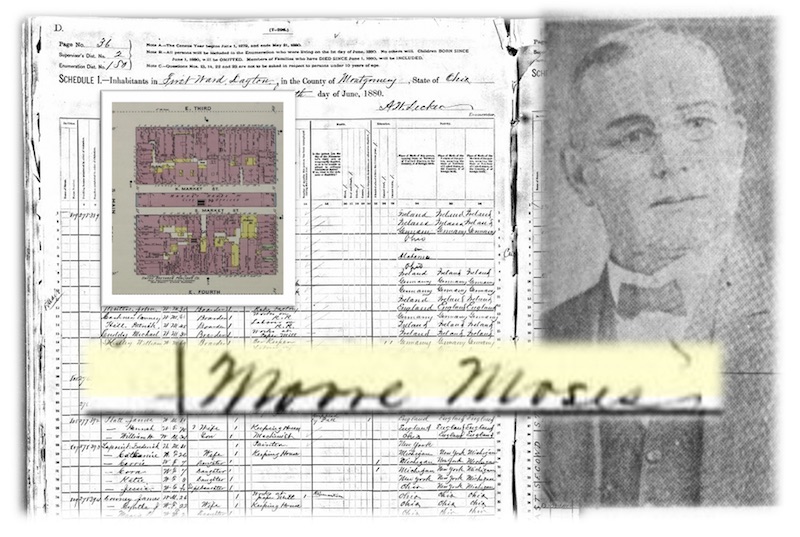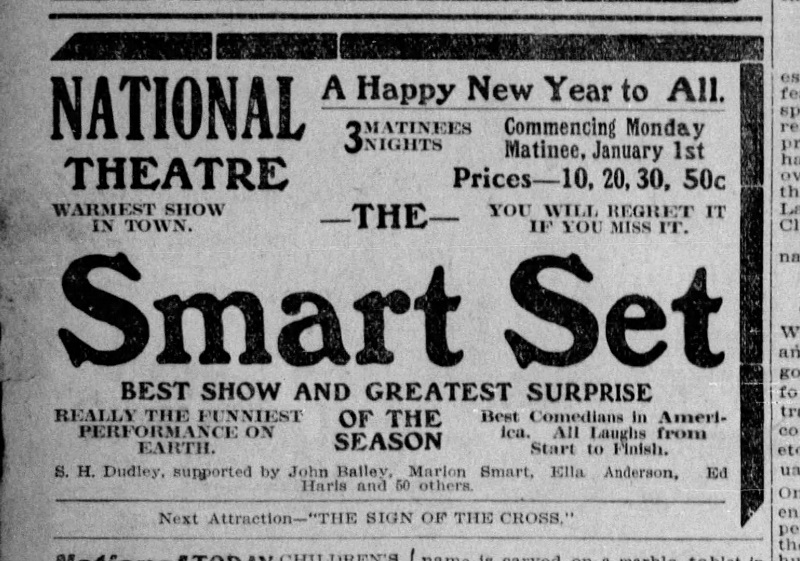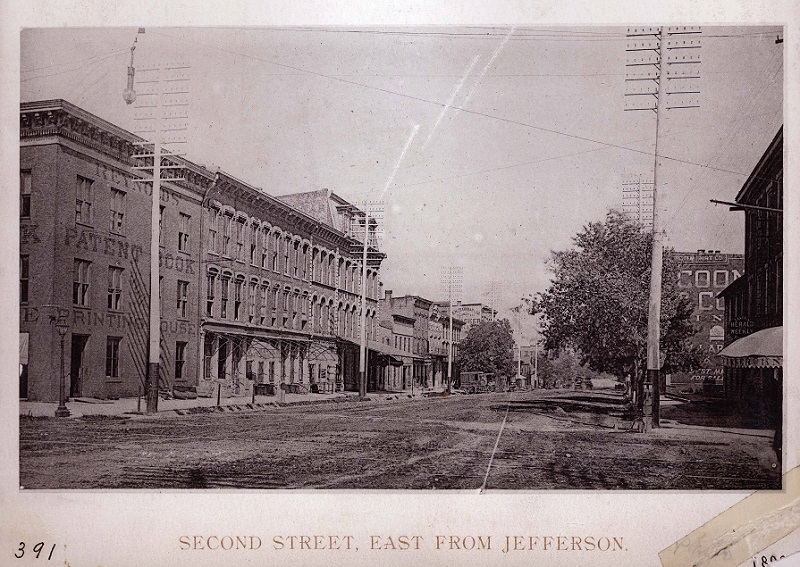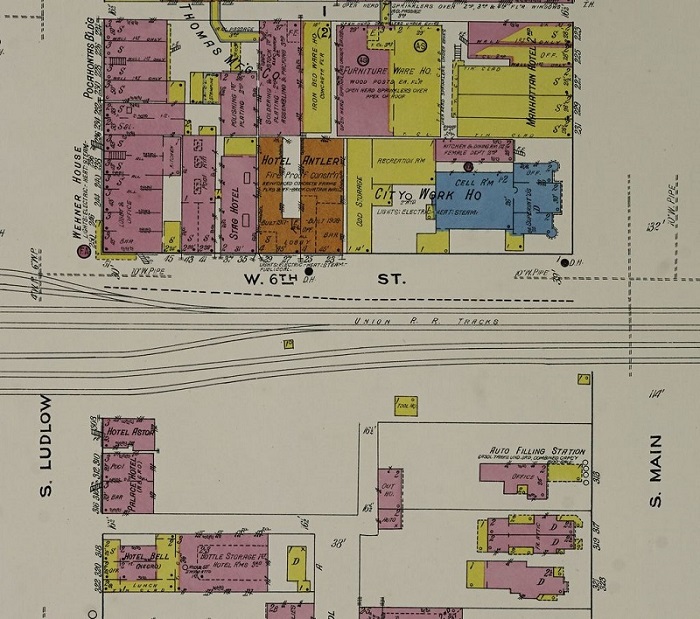University Libraries

Moses Moore: Business Grows
By Heidi Gauder
Part 3 of 6 in a documentary biography of Moses Moore, who became known as the wealthiest Black man in Dayton in the late 1800s. Librarian Heidi Gauder pieced together his history from census records, maps, newspaper clippings and local histories. You can read the other installments on the Roesch Library blog:
- Moses Moore: A Documentary Biography
- Moses Moore: Political Action
- Moses Moore: Entertainment and Sports
- Moses Moore: Building Portfolio
- Moses Moore: Community Needs
The 1900 U.S. census showed that the city of Dayton had grown to 85,333 people, of whom 3,410 — or 4% — were African American. On that Census, Moore was living with his wife, Martha, on South Market street, making a living as a saloon keeper. They were not the only people to live in this particular building, as 24 boarders were listed with the Moore family. All of the occupants were African American and likely worked at the saloon or nearby, as their occupations included saloon manager, cook, porter, waiter, and barber.
Although Moore was thriving in his businesses and horse-racing endeavors, some tragedies came upon his family life. Woodland Cemetery records indicate that an infant of Moore died in May 1891, and a son, Moses F. Moore, died in November 1899 of diphtheria. Less than a year after this death, in September 1900, the Dayton Daily News briefly noted that Moore had filed an inventory in his capacity as Martha’s guardian. Court documents from the time indicate that Martha was an “adjudged lunatic” (today’s legal term is incompetent). She died Dec. 22, 1900. Martha’s estate included $265 in cash and $4,200 in real estate; taken together, this sum would be the equivalent of $145,000 today.
Several years later, Moore married Marion Henry, who went by the stage name Marion Smart. She was a member of the traveling singing troupe known as the Smart Set, “an animated mixture of dancing, melody and comedy.” Though it is not clear how Moore met Smart, the Smart Set entertained in Dayton in November 1904; the theater review noted, “Marion Smart and John Bailey in their singing specialty and shadow dancing were given numerous recalls.” They were married Aug. 7, 1906, in Marion’s hometown of Boston; Marion was 26, and Moore was 54. That happy occasion would be marred later that year with the death of Moore’s son, Richard J. Moore, who passed away Nov. 2, 1906, at the age of 13 following a short illness.
Newspaper crusade
Moore’s establishments often appeared in the newspapers, usually as locales for fights, stabbings and police raids for gambling. In 1901, the Dayton Daily News took particular affront to Moore’s businesses, and for a couple months, it ran editorials decrying the levels of vice throughout the city, holding up Moore’s businesses as prime examples. After a quarrel at Moore’s roadhouse left a stabbing victim in critical condition, the newspaper on April 15 proclaimed, “Stamp out this hell-hole,” noting, “Mose Moore has been a blot on decency in Dayton a long time, and his brazen indifference to law has been so notorious as to excite the suspicion that he had friends at court.” On April 16, the newspaper ran an editorial titled, “A rendezvous for criminal classes is Mose Moore's infamous roadhouse,” and on April 17, the newspaper’s headline boasted, “Crusade begun by the news against the hell-holes bears fruit early,” as a raid on Moore’s Market Street saloon and hotel yielded 23 arrests.
The newspaper continued with colorful editorials throughout the rest of the month, noting that there were “too many crime-breeding dens in the city and its immediate environs” — but it remained focused on Moore’s businesses. On May 2, the newspaper impatiently declared, “The failure of the police department to follow up the raid on Mose Moore’s hell-hole of crime and debauchery is a circumstance calculated to arouse all kinds of suspicion.” On May 7, the newspaper called upon members of the police board to do their duty and stamp out the “colored dives” and went on to identify a number of them. The charges of gambling at Moore’s roadhouse were dismissed later that month, prompting the newspaper to assert a “disgrace wrought by the grand jury.”
This headline was the last one before a May election, where voters in what was then Harrison Township voted “against the sale” (of liquor) by a margin of 20 votes. Moore’s roadhouse was located just barely inside the township and forced to go dry as a result. In response, Moore built an extension onto his roadhouse and moved the saloon inside the city limits. Another raid in July yielded 17 arrests and another charge of running a gambling place. This time, Moore pleaded guilty and was fined $30 and costs — and the gambling equipment was burned the next day. The Daily News finally had the headline it wanted: “Mose Moore’s gambling apparatus reduced to ashes with a public display.”
The raids continue
For nearly the rest of the decade, Moore contended with raids on his Market Street saloon and roadhouse on Germantown Street, most notably in 1904 and 1908, and his saloons remained on the police blotters as locations for criminal activity. He merited periodic mentions in Dayton Daily News editorials, which often linked his character to his business dealings and political connections. In the middle of a mayoral contest, a 1903 editorial asserted, “Moore has been a disgrace to Dayton. He has been a canker sore on the community for years. He is responsible for the large increase of colored crooks. … He manifestly knows his ground in sticking by Lowes.* No political shell game can be worked on by him.”
Next venture: Real estate
By the close of the first decade, Moore looked to new opportunities in the real estate business. At the end of 1908, he sold his Market Street property for $27,000 to the United Brethren Publishing Co. The company had already built a structure at Main and Fourth streets in 1904 and was looking to expand north toward Market Street (this building is now known as the Centre City Building). Moore, however, continued to maintain a presence on Market Street, leasing property next door to his former saloon from Elizabeth Richter, who was better known as Lib Hedges. This arrangement proved to be temporary, however, ending after the United Brethren Publishing Co. purchased the Richter property in August 1909. Shortly after this transaction, Moore purchased a building at 27 E. Sixth St. City directories from the time list the Moore family as living at 217 S. Perry St., a departure from previous entries, when they were listed at either the Market Street hotel or the roadhouse on Germantown Street. These land transactions in downtown Dayton were only part of Moore’s real estate and business plans in the coming years.
* Joseph E. Lowes was a Dayton physician and staunch Republican, according to his biography on Page 222 of W.H. Beers & Co.’s The History of Montgomery County, Ohio (1882).
— Heidi Gauder is a professor in the University Libraries and coordinator of research and instruction. In locating records and information about Moses Moore and his family, she received assistance from Suzanne Dungan, Paris-Bourbon County (Kentucky) Public Library; Shawna Woodard, Special Collections, Dayton Metro Library; and Amy Czubak, Montgomery County (Ohio) Records Center and Archives. View the sources used in this series.



